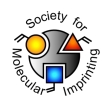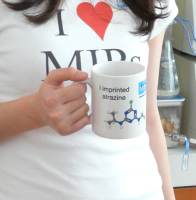
Authors: Gao BJ, Zhang YY, Chen T
Article Title: Designing and preparing of quercetin surface-imprinted material and its molecular recognition characteristics.
Publication date: 2014
Journal: Journal of Applied Polymer Science
Volume: 131
Issue: (22)
Page numbers: n/a.
DOI: 10.1002/app.41112
Abstract: Quercetin is an important compound of flavonoids. In this work, quercetin molecule surface-imprinted material with high performance was prepared using a novel surface-imprinting technique of "synchronously graft-polymerizing and imprinting." The modified micron-sized silica gel particles containing amino groups were used as matrix, methacrylic acid (MAA) was used as functional monomer, and N,N'-Methylenebisacrylamide (MBA) was used as crosslinker. In dimethyl formamide solution of quercetin, MAA molecules arranged automatically around the template quercetin molecule by right of hydrogen bonding interactions of two type, ordinary hydrogen bond and π-type hydrogen bond. By initiating the surface-initiating system of -NH2/S2O82-, the graft/cross-linking polymerization of MAA on SiO2 particles and the quercetin molecule surface-imprinting were simultaneously carried out, forming quercetin molecule surface-imprinted material MIP-PMAA/SiO2. With another two flavonoids, rutin and genistein, as contrasting substances, the molecule recognition character of the quercetin molecule surface-imprinted material MIP-PMAA/SiO2 was investigated with batch and column methods. The experimental results show that the imprinted material MIP-PMAA/SiO2 possesses special recognition selectivity and excellent binding affinity for quercetin molecule. The binding capacity of MIP-PMAA/SiO2 for quercetin is 0.325 mmol/g, and its selectivity coefficients for quercetin relative to rutin and genistein are 7.69 and 4.40, respectively. The main conditions of imprinting process affect the property of MIP-PMAA/SiO2 greatly, and the optimal molar ratio of monomer MAA to crosslinker MBA is 7 : 1 and appropriate molar ratio of monomer MAA to template quercetin is equal to 6 : 1. © 2014 Wiley Periodicals, Inc. J. Appl. Polym. Sci. 2014, 131, 41112
Template and target information: quercetin
Author keywords: grafting, molecular recognition, separation techniques



Join the Society for Molecular Imprinting

New items RSS feed
Sign-up for e-mail updates:
Choose between receiving an occasional newsletter or more frequent e-mail alerts.
Click here to go to the sign-up page.
Is your name elemental or peptidic? Enter your name and find out by clicking either of the buttons below!
Other products you may like:
 MIPdatabase
MIPdatabase









